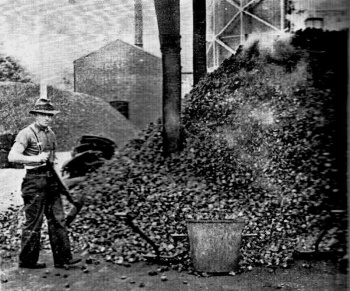We recall with something akin to panic the moment of nausea experienced in our schoolboy stomachn when the headmaster announced from the rostrum that members of the sixth form would be excused lessons for an instructional visit to the gas works. To our infant minds there was something particularly sooty and deadly about such a pilgrimage.
Mr S P Pepin
However, it was with no such feelings that we stepped out under the tutelage of Mr S P Pepin, engineer and manager of our own Jersey Gas Light Company, to discover at the source the more human and intelligible phases of this warming, cooking and lighting business as it particularly applies to us and to our readers.
It was quite apparent at the start that Mr Pepin was no cadaverous pedagogue, sadistically determined to cram large hunks of predigested carbon down our throats and make us like it; on the contrary, he gave us the impression of a man convincingly proud in the possession of a rare treasure house who was about to open the door with a golden key because he loved it and liked us, and we were consequently agog to glimpse behind the scenes.
Located on a valuable block of real estate between Bath Street and St Saviour’s Road, the gas and coke plant was erected in 1897 and with periodic modernisation and extensions has been serving the island with increasing credit ever since.
Each year about 21,000 tons of gas-producing coal from the Wearmouth colleries in Durham arrive in Jersey in British bottoms, for carbonization in the St Helier plant. We watched a lorry load of this coal being tipped into the bins from where it was carried on conveyor chains to the carbonizing plant.
Carbonizing plant
The carbonizing plant is an imposing structure, sooty if you like, but ‘infernally’ adequate and operated by a number of smoky satellites suggestive of Dante’s nethermost pit, but answering cheerfully to the commonplace names of Peter, Bill or Jim as the case happened to be, and apparently quite reconciled to their local ‘Hades’.
They had kept him waiting at the door. But Mr Pepin didn’t keep us waiting – he showed us the coal being ushered into one of the retorts (long tubular ovens in which the coal is carbonized) eight of which retorts make up a ‘setting’, the entire plant consisting of 12 settings.
Until 1931 the coal was introduced by mkanual labour, but today a large machine operating on a railway track and served by conveyor chains, backs up to the opened end of the retort and pushes the fresh coal in to take the place of the carbonized coal which is ejected as coke at the other end, where it is in turn carried out by underground conveyor chains, copoled by water, and thence by overhead conveyors to the coke stacks, where it is graded for specialised use.
The retorts are heated by underground coke furnaces generating a temperature of 1,200 degrees centigrade, and the gas distilled from the coal in the retorts rises through ascension pipes and is drawn off by engines working in an adjacent building, to be purified.
These engines propel the gas in turn through five purifying plants: the first, a condenser to remove the tar and cool the gas; the second, a tarwasher to thoroughly remove all traces of tar fog; the third, a washer-scrubber to absorb the ammonia; the fourth, an oil washer to eliminate benzol; and the fifrth, a series of boxes each containing about 80 tons of iron oxide, which remove all traces of sulphurated hydrogen.
The by-produces of all these processes are collected and sold to the trade.
Gas holders
After purification the gas passes through a station meter of 60,000 cubic feet per hour capacity and thence to the ‘holders’ those large round things which go up and down and identify the gasworks in any community.
The gas is now ready for transmission through the pipes which remificate through the island to the consumers, where it is used variously to fry kippers and cook meals, warm the room in winter, cool the fridge in summer, heat the water in summer as well as winter, and to provide illumination with which to follow the peregrinations of the Colorado Beetle through the pages of the local dailies.
Owing to our insular situation the Jersey Gas Light Company is perforce obliged to be self-sufficient in the matter of repairs and spare parts, and it is consdquently equipped with the most up-to-date workshops and expert technicians who will see to it that at least we will have our gas and coke even if most thoroughly ‘encircled’ and ‘marooned’ in any presumable international dust-up to come. We should derive much comfort from this thought in these parlous times.
And should it be necessary in any imaginable emergency to cut off the gas supply or isolate a district, there is an elaborate system of control which can be made effective at a moment’s notice.
Amazing as it seems, although the thousands of tons of coal and coke and by-products come in and go out every year, the precincts of the Jersey coke and gas plant are at all times immaculate and spotless and are a credit to the tidy minds of the personnel.


